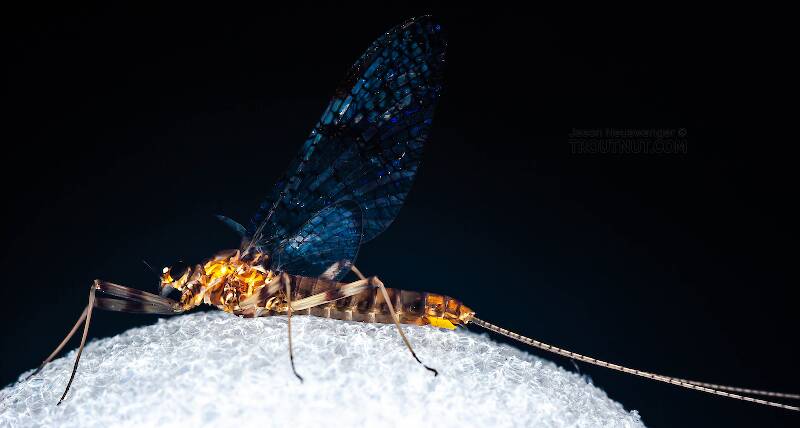
Salmonflies
Pteronarcys californica
The giant Salmonflies of the Western mountains are legendary for their proclivity to elicit consistent dry-fly action and ferocious strikes.


Mayfly Species Stenonema pudicum
Species Range
Physical description
Most physical descriptions on Troutnut are direct or slightly edited quotes from the original scientific sources describing or updating the species, although there may be errors in copying them to this website. Such descriptions aren't always definitive, because species often turn out to be more variable than the original describers observed. In some cases, only a single specimen was described! However, they are useful starting points.
Male Spinner
Wing length: 13-14 mm
A rather large species, allied to Stenonema vicarium; hind wing dark-margined; cross veins crowded at bulla; sagittate dark mid-dorsal streak on tergites.
Head reddish brown; from lower corner of eye a transverse purple-black line passes under antenna and across carina; orange-red shading below antenna; ocelli black-ringed at base. Vertex with blackish shading between ocelli; oblique streaks from median line to posterior margin. Pronotum deep red-brown; geminate purplish black median streak, darker anteriorly; posterior margin black in median area; purplish streak from margin to trochanter of fore leg. Mesonotum yellowish brown, red-brown anteriorly; scutellum and adjacent areas blackish brown; margins and sutures red-brown. Metanotum dark red-brown. A large pale area anterior to wing roots; postero-lateral area of pronotum pale. Pleura dark red-brown, intersegmental areas yellowish; sutures narrowly blackish. Small purplish spots on each side of middle and hind coxae. Sternum dark red-brown, pale areas around leg bases. Coxae and trochanters of all legs red-brown. Fore leg yellowish to olive brown; wide purple-brown median and apical hands on femur; apex of tibia black; claws, distal tarsal joint, and tarsal joinings narrowly brown. Basal joint of fore tarsus more than 1/2, sometimes almost 2/3 length of second. Middle and hind legs paler yellowish olive; purplish median and apical bands on femora prominent; tarsal joinings deep brown, tarsi may be slightly smoky. Wings hyaline, but with very faint milky tinge: Many cross veins crowded together at bullar region, in first 6 to 8 spaces, and margined with dark brown, forming a dark curved streak in wing. Costa, subcosta and radius thickened, amber or deep yellow; other longitudinal veins of fore wing dark red-brown, finer. Cross veins purplish black, thicker than longitudinals; many in costal border and in disc are dark-margined. Distinct reddish brown stain in stigmatic area, in costal and subcostal spaces. Hind wing with a rather wide purplish outer margin; veins yellow-brown anteriorly, pale yellow posteriorly. See drawing of wing, fig. 29.
Abdominal segments yellowish olive tinged with reddish or purplish brown; tergites darker than sternites, which are distinctly yellowish. On each tergite a rather wide purplish black posterior margin, widest on anterior segments, where half to two-thirds of tergite may be dark. A sagittate dark mark at mid-dorsal line of each, based on posterior margin and reaching about to center of segment. Laterally, at end of each dark band, an irregular triangular mark of some color as band; apex of triangle extends toward center of segment; lateral areas in some specimens largely dark except for a single pale oval area. Pleural fold may be narrowly whitish. Narrow dark shading at anterior and lateral margins of sternites; ganglionic area whitish, other portions may be slightly grey-tinged. Genitalia pale brownish; penes much as in tripunctatum (now a synonym of Stenonema femoratum) but apical margin more rounded, inner margin less distinctly incurved. Tails greyish white, joinings purplish brown; alternate joinings wider.
The crowding of cross veins at bulla seems to ally this species with S. tripunctatum and femoratum; the dark-margined hind wing separates it from the former, the sagittate mid-dorsal mark and uninterrupted dark posterior margins distinguish it from the latter species. However, the nymphal characters and genitalia are closer to Stenonema vicarium, which lacks the dark-margined hind wing.
Specimens of the Mayfly Species Stenonema pudicum
1 Female Spinner

Start a Discussion of Stenonema pudicum
References
- Needham, James G., Jay R. Traver, and Yin-Chi Hsu. 1935. The Biology of Mayflies. Comstock Publishing Company, Inc.
Mayfly Species Stenonema pudicum
Species Range
Resources
- NatureServe
- Integrated Taxonomic Information System
- Global Biodiversity Information Facility
- Described by Hagen (1861)

